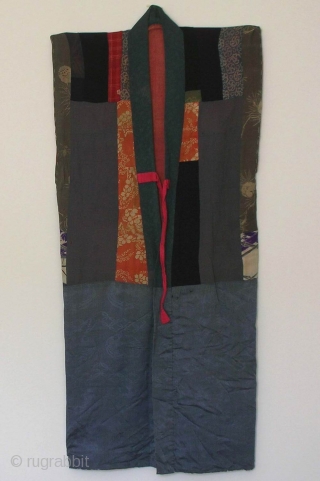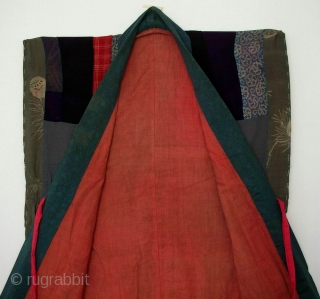Back
Yose juban, Japan, Edo (circa 1800), cm 130x60. The ‘juban’ is a garment which is worn under a kimono. As ‘yose’ means ‘pieced’, those obtained by hand-sewing together silks from discarded kimonos were called ‘yose juban’. Note the profusion of types of silks (among them a lot of shibori cloths) and the swirling combination of colors, all of which are botanical. Chief among the dyestuffs are blue (indigo), purple (gromwell root), and orange. The cotton lining is orange, quite typical of this kind of early 19th century undergarment, and the dyestuff used to create this pure orange is safflower, called ‘benibana’ in Japan. The result of assembling together these of multi-coloured silks is amazing. The juban shows signs of age, such as a tear in the lining and little scattered holes, but this is to be expected in an item that has been worn for most of its 200 years of life, and it doesn’t detract a bit from its appeal. Lovely and very much recommended.
price:
SOLD
- Home
- Antique Rugs by Region
- Category
- Profiles
- Post Items Free
- Albums
- Benaki Museum of Islamic Art
- Budapest: Ottoman Carpets
- Gulbenkian Museum
- Islamic Carpets. Brooklyn
- Islamic Textiles. Brooklyn
- Konya Museum: Rugs
- MKG, Hamburg
- MMA: Caucasian Carpets
- MMA: Mamluk Carpets
- MMA: Mughal Indian Carpets
- MMA: Ottoman Carpets
- MMA: Safavid Persian Carpets
- MMA: Turkmen Rugs
- McCoy Jones Kilims
- Ottoman textiles. Met
- Philadelphia Museum
- Rugs and Carpets: Berlin
- Seljuqs at the Met
- TIEM, Istanbul: Carpets
- V&A: Classical Carpets
- Vakiflar Carpets: Istanbul
- Baluch Rugs: Indianapolis
- Gallery Exhibitions
- Jaf an Exhibition
- Alberto Levi Gallery
- Andean Textile
- Christie's London: 2016
- Francesca Galloway
- HALI at 40
- ICOC Washington, DC 2018
- Jajims of the Shahsavan
- London Islamic Week April, 2018
- Mongolian Felts
- Navajo Rugs: JB Moore
- Persian Piled Weavings
- SF Tribal & Textile Art Show 2020
- SF Tribal 2019
- Sotheby's: C. Alexander
- Turkish Prayer Rugs
- Turkmen Main Carpets ICOC 2007












